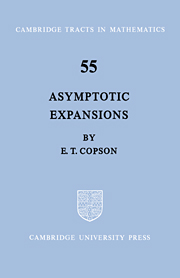10 - Uniform asymptotic expansions
Published online by Cambridge University Press: 14 September 2009
Summary
The asymptotic expansions of Jν(νa)
We saw in sections 32 and 33 that, when ν is large and a is fixed, the function Jν(νa) has, in general, an asymptotic expansion which involves an infinite series of negative powers of ν½, but that, when a = 1, the expansion involves an infinite series of negative powers of ν⅓. This change of form as a → 1 was caused by the fact that two saddle-points which are distinct when a ┼ 1, coalesce as a → 1 to form a saddle-point of higher order. Evidently a phenomenon of this kind must always occur when two saddle-points coalesce in this way.
This change of form in the asymptotic expansion of Jν(νa) (and, of course, of other functions which behave in a similar way) makes it desirable to have an asymptotic expansion valid uniformly in a neighbourhood of the exceptional value of the parameter.
One way of attaining this end is to go back to the differential equation satisfied by Jν(νa) regarded as a function of the parameter a. By a somewhat complicated change of variables, this equation can be transformed into one which is approximately the same as the equation satisfied by Airy's integral: and one can then argue that approximately identical differential equations will have approximately identical solutions. In this way, Langer [18] obtained a uniform asymptotic approximation to Jν(νa) when ν is large.
- Type
- Chapter
- Information
- Asymptotic Expansions , pp. 107 - 117Publisher: Cambridge University PressPrint publication year: 1965

